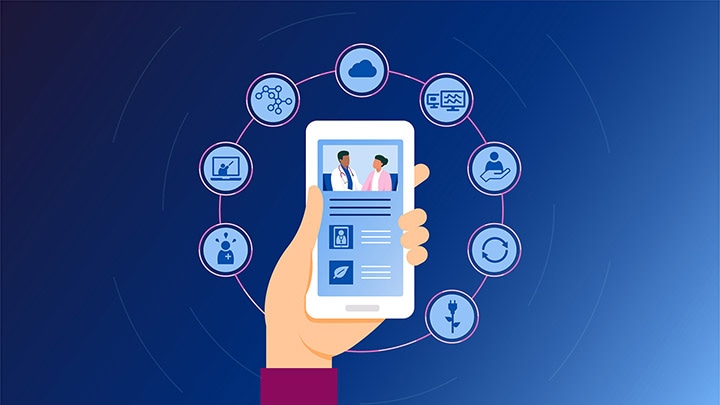Table of Contents
The advent of telemedicine has revolutionized the way healthcare is delivered, transforming traditional medical practices and expanding the role of medical professionals. In an era marked by technological advancements and the need for accessible and convenient healthcare, telemedicine has emerged as a game-changer. This article explores the impact of telemedicine on the changing role of medical professionals, highlighting its benefits, challenges, and implications for the future of healthcare.
The advent of telemedicine has revolutionized the way healthcare is delivered, transforming traditional medical practices and expanding the role of medical professionals in unprecedented ways. In an era marked by rapid technological advancements and an ever-increasing demand for accessible and convenient healthcare, telemedicine has emerged as a true game-changer.
One of the most significant impacts of telemedicine is the democratization of healthcare services. Geographic barriers are no longer insurmountable obstacles for patients seeking medical attention. Through telemedicine, medical professionals can reach patients in remote or underserved areas, bridging the gap between urban and rural healthcare access. This newfound accessibility not only benefits patients but also empowers healthcare providers to serve a broader and more diverse patient population.
Moreover, telemedicine has redefined the role of medical professionals by fostering greater collaboration and interdisciplinary care. Virtual consultations allow specialists from different geographical locations to consult on complex cases, providing patients with a more comprehensive and holistic approach to healthcare. This collaborative model not only enhances patient outcomes but also expands the knowledge and expertise of medical professionals.
Telemedicine has also given rise to new career opportunities for medical professionals. Telehealth platforms, remote monitoring systems, and telemedicine companies require a range of healthcare professionals, from physicians and nurses to medical technologists and data analysts. As the telemedicine industry continues to grow, so does the demand for skilled professionals who can navigate this digital frontier.
However, telemedicine is not without its challenges. Issues related to privacy, data security, and regulatory compliance must be carefully addressed to ensure patient confidentiality and maintain the highest standards of care. Additionally, the digital divide remains a concern, as not all patients have equal access to the necessary technology and internet connectivity for telemedicine services.
In conclusion, telemedicine is reshaping the landscape of healthcare delivery and redefining the roles of medical professionals. Its benefits in terms of accessibility, collaboration, and career opportunities are undeniable. However, addressing its challenges and ensuring that telemedicine is integrated thoughtfully and ethically into healthcare systems will be essential for harnessing its full potential in the future of healthcare. As technology continues to advance, the role of medical professionals will continue to evolve alongside it, creating a healthcare system that is more adaptable, accessible, and patient-centered than ever before.
If you’d like to dive deeper into this subject, there’s more to discover on this page: Framework for the Implementation of a Telemedicine Service
Telemedicine: A Transformative Force
Telemedicine, broadly defined as the use of technology to provide remote healthcare services, has rapidly gained popularity in recent years. It encompasses various modes of communication, including video calls, phone consultations, and secure messaging platforms, allowing patients to access medical expertise from the comfort of their homes.
One of the key benefits of telemedicine is its ability to break down geographical barriers. Patients in remote or underserved areas can now connect with healthcare providers from around the world, ensuring that medical expertise is not confined by geographic constraints. This democratization of healthcare has expanded access to quality care and specialized expertise, regardless of a patient’s location.
To delve further into this matter, we encourage you to check out the additional resources provided here: Telemedicine for healthcare: Capabilities, features, barriers, and …

Medical Professionals as Digital Caregivers
Telemedicine has redefined the role of medical professionals as digital caregivers. Doctors, nurses, and other healthcare providers are now leveraging technology to diagnose, treat, and monitor patients remotely. This shift has broadened their scope of practice beyond traditional clinical settings. Medical professionals are not only seeing patients in person but are also engaging in virtual consultations, offering advice through telehealth platforms, and remotely monitoring patients’ health.
Furthermore, telemedicine has led to the rise of telehealth specialists—medical professionals who focus on providing care exclusively through digital means. These specialists offer expertise in virtual care, ensuring that patients receive the highest quality of care even in the absence of physical interaction. They are at the forefront of innovation, using technology to enhance the patient-provider relationship.
Looking for more insights? You’ll find them right here in our extended coverage: What is digital health (digital healthcare) and why is it important?

Benefits and Challenges
The adoption of telemedicine offers numerous advantages. It enhances accessibility, reduces healthcare costs, and minimizes the need for travel, particularly for follow-up appointments and routine check-ups. Telemedicine also promotes early intervention and preventive care, as patients are more likely to seek medical advice when it’s readily available.
However, telemedicine also presents challenges. Ensuring data privacy and security is paramount, as medical information is transmitted electronically. Additionally, there is a learning curve for both patients and medical professionals in adapting to virtual care. The absence of physical examinations in some cases may limit the ability to diagnose certain conditions accurately.
Explore this link for a more extensive examination of the topic: Telemedicine for healthcare: Capabilities, features, barriers, and …

The Future of Healthcare
The changing role of medical professionals in the era of telemedicine is a testament to the adaptability of the healthcare industry. While in-person care remains essential for many medical procedures, telemedicine complements traditional practices by offering a more accessible and patient-centric approach.
As technology continues to advance, the integration of artificial intelligence, remote monitoring devices, and telehealth platforms will further transform healthcare delivery. Medical professionals will need to embrace these changes, expanding their skill sets to excel in the digital healthcare landscape.
The dynamic evolution of medical professionals in the era of telemedicine underscores the remarkable adaptability of the healthcare sector. While in-person care remains indispensable, telemedicine introduces a revolutionary dimension, enhancing accessibility and prioritizing a patient-centric approach.
Telemedicine transcends geographical barriers, ensuring that medical expertise can reach patients in remote areas or during emergencies swiftly. It optimizes the use of technology, empowering medical practitioners to diagnose, treat, and monitor patients more efficiently. The integration of artificial intelligence and remote monitoring devices further augments the accuracy and effectiveness of healthcare delivery.
In this digital healthcare landscape, medical professionals are not just caregivers but also innovators. They must continually expand their skill sets to navigate and harness these transformative technologies effectively. Embracing telemedicine doesn’t diminish the importance of traditional medical practices; it enhances them, allowing professionals to provide holistic and comprehensive care.
As we look to the future, medical professionals should embrace these changes with open arms, acknowledging that the synergy between tradition and technology will drive healthcare forward. This adaptability and dedication to continuous learning will ensure that they remain at the forefront of patient care in the ever-evolving world of medicine.
If you’d like to dive deeper into this subject, there’s more to discover on this page: Telemedicine for healthcare: Capabilities, features, barriers, and …

In conclusion, telemedicine is reshaping the role of medical professionals, making them not just caregivers within the confines of hospitals and clinics but also digital healthcare providers. This transformation is driven by the imperative to make healthcare more accessible, convenient, and efficient for patients. As telemedicine continues to evolve, so too will the role of medical professionals, ensuring that the future of healthcare is marked by innovation and inclusivity.
In conclusion, telemedicine represents a paradigm shift in the healthcare landscape, pushing the boundaries of traditional medical practice. It’s transforming medical professionals into versatile digital healthcare providers who can reach patients across geographic and temporal boundaries. This transformation is not just about adopting new technology; it’s a fundamental shift in the way we approach healthcare.
1. Expanding Reach: Telemedicine erases the limitations of geography, allowing medical professionals to extend their expertise to underserved and remote areas. This means that patients in rural communities, for instance, can access the same level of care as those in urban centers.
2. Convenience: Patients now have the convenience of receiving medical advice and treatment from the comfort of their homes. This is especially valuable for individuals with mobility issues, busy schedules, or those who simply prefer the ease of virtual visits.
3. Proactive Care: Telemedicine enables medical professionals to engage in proactive healthcare. Remote monitoring and telehealth consultations empower doctors to identify potential issues before they escalate, thus improving overall health outcomes.
4. Cost-Effective: It’s not just patients who benefit from telemedicine; it’s also cost-effective for healthcare systems. Reduced hospital admissions, fewer emergency room visits, and optimized resource allocation all contribute to financial sustainability.
5. Continuity of Care: Telemedicine enhances continuity of care. Patients can stay connected with their healthcare providers, fostering ongoing relationships and personalized treatment plans.
6. Innovation: As telemedicine continues to evolve, it will lead to even more innovative healthcare solutions. The integration of AI, wearables, and remote diagnostics promises to revolutionize how we diagnose and treat medical conditions.
7. Inclusivity: Telemedicine holds the promise of making healthcare more inclusive. It can bridge gaps in healthcare access, reducing health disparities and ensuring that everyone, regardless of their location or circumstances, has access to quality care.
8. Collaboration: The digital transformation of healthcare fosters collaboration among medical professionals, enabling them to consult with specialists worldwide. This collaborative approach can lead to more accurate diagnoses and treatment plans.
In essence, telemedicine is not just a tool but a catalyst for change in the healthcare industry. It’s ushering in an era where medical professionals are not confined by physical boundaries but are empowered by technology to deliver healthcare that is accessible, convenient, and efficient. As telemedicine continues to evolve, it promises to shape a future where healthcare is not just a service but a fundamental human right accessible to all.
To expand your knowledge on this subject, make sure to read on at this location: Transforming Interprofessional Roles During Virtual Health Care …
More links
Additionally, you can find further information on this topic by visiting this page: The Evolution of Telehealth: Where Have We Been and Where Are …
